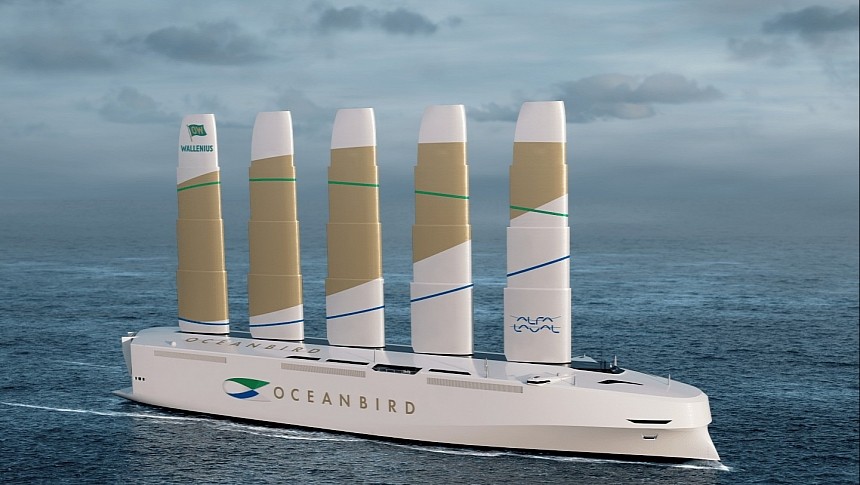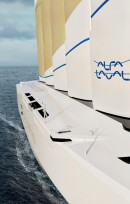One of the most acclaimed wind-assisted propulsion systems (WAPS) is closer to becoming reality. Oceanbird is ready to tackle the highly-anticipated prototype assembly phase after obtaining official approval from the DNV classification society for its game-changing concept.
In 2020, Wallenius Marine, a reputable player in the shipping industry, announced its intention to bring to life a trailblazing wind-powered ship in collaboration with several institutions in Sweden. One year later, it officially launched a joint venture with its industrial partner, Alfa Laval. The new company was named Oceanbird, just like the innovative sailing concept it plans to commercialize.
Two years later, the first wing sail from Oceanbird, called Wing 560, was granted Approval in Principle (AiP) from DNV, the leading classification society. This is basically a confirmation of the concept’s feasibility and safety. The company's representatives say that they've asked for a comprehensive review of the design, even going beyond the minimal requirements, so that any potential uncertainties could be eliminated.
What makes this particular wing sail concept highly innovative and also challenging is that it's a stiff sail that can tilt in the wind. It claims to be one of the few of its kind. This is described as an important safety characteristic. The extensive review focused, among other things, on the sail's capacity to withstand extreme weather conditions.
After this milestone, the Swedish company is ready to start assembling its full-scale wing prototype onboard a vessel. This step of the process is expected to be completed in one year from now.
According to its creators, Oceanbird is more similar to aircraft wings than conventional sails due to its focus on aerodynamics. When a vessel fitted with the Oceanbird system needs to pass under a bridge, enter a harbor, or deal with strong winds, the entire wing sail is tilted only after its smaller segment perfectly folds into the other segment.
The Swedish WAPS promises to cut shipping-related emissions by up to 90% while also drastically reducing underwater sound pollution, which would have a huge positive impact on marine life.
Initially, Oceanbird was planning to install the wing sail on a 200-meter (656-foot) cargo ship. Due to the telescopic structure of the Oceanbird sails, this would have been the tallest ship in the world, boasting a height above the waterline of 105 meters (344 feet). It would combine the capacity to carry 7,000 cars with this innovative wind-assisted propulsion system, allowing it to cross the Atlantic in 12 days.
We'll have to wait and see where and how Oceanbird will complete its first installation. What's important to note is that the concept was designed to be agnostic, which means it can be easily installed on any type of commercial vessel.
Two years later, the first wing sail from Oceanbird, called Wing 560, was granted Approval in Principle (AiP) from DNV, the leading classification society. This is basically a confirmation of the concept’s feasibility and safety. The company's representatives say that they've asked for a comprehensive review of the design, even going beyond the minimal requirements, so that any potential uncertainties could be eliminated.
What makes this particular wing sail concept highly innovative and also challenging is that it's a stiff sail that can tilt in the wind. It claims to be one of the few of its kind. This is described as an important safety characteristic. The extensive review focused, among other things, on the sail's capacity to withstand extreme weather conditions.
After this milestone, the Swedish company is ready to start assembling its full-scale wing prototype onboard a vessel. This step of the process is expected to be completed in one year from now.
According to its creators, Oceanbird is more similar to aircraft wings than conventional sails due to its focus on aerodynamics. When a vessel fitted with the Oceanbird system needs to pass under a bridge, enter a harbor, or deal with strong winds, the entire wing sail is tilted only after its smaller segment perfectly folds into the other segment.
The Swedish WAPS promises to cut shipping-related emissions by up to 90% while also drastically reducing underwater sound pollution, which would have a huge positive impact on marine life.
Initially, Oceanbird was planning to install the wing sail on a 200-meter (656-foot) cargo ship. Due to the telescopic structure of the Oceanbird sails, this would have been the tallest ship in the world, boasting a height above the waterline of 105 meters (344 feet). It would combine the capacity to carry 7,000 cars with this innovative wind-assisted propulsion system, allowing it to cross the Atlantic in 12 days.
We'll have to wait and see where and how Oceanbird will complete its first installation. What's important to note is that the concept was designed to be agnostic, which means it can be easily installed on any type of commercial vessel.








